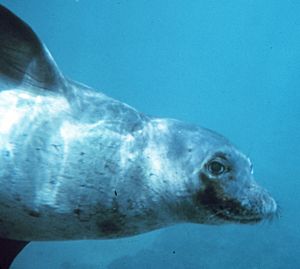Hawaiian monk seal facts for kids
Quick facts for kids Hawaiian monk seal |
|
|---|---|
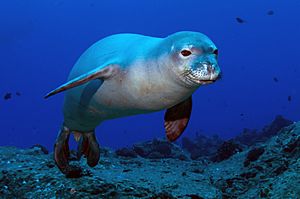 |
|
| Conservation status | |
| Scientific classification | |
| Kingdom: | |
| Phylum: | |
| Class: | |
| Order: | |
| Family: | |
| Genus: | |
| Species: |
M. schauinslandi
|
| Binomial name | |
| Monachus schauinslandi Matschie, 1905
|
|
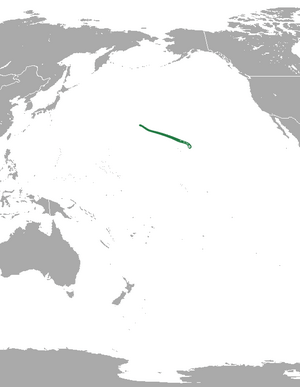 |
|
| Hawaiian monk seal range | |
The Hawaiian monk seal (Neomonachus schauinslandi) is a special type of earless seal. It is an endangered species, meaning there are not many left. These seals live only in the Hawaiian Islands. They are the only seals that call Hawaii home.
There are only two types of monk seals left in the world. One is the Hawaiian monk seal. The other is the Mediterranean monk seal. Sadly, a third type, the Caribbean monk seal, is now extinct. About 1,400 Hawaiian monk seals are alive today. They face threats like getting caught in fishing nets, diseases, and trash in the ocean. People are working hard to protect them. This includes moving seals to new places and cleaning up their homes.
What's in a Name?
Native Hawaiians call this seal ʻIlio-holo-i-ka-uaua. This means "dog that runs in rough water." Its scientific name comes from Hugo Schauinsland. He was a German scientist who found a skull in 1899. The seal's common name, "monk seal," comes from the short hairs on its head. These hairs look a bit like a monk's hood. This seal is the official state mammal of Hawaii.
How to Spot a Hawaiian Monk Seal
Hawaiian monk seals have a grey coat and a white belly. They are also quite slender. This helps them hunt for food. They love to eat fish, lobster, octopus, and squid. They find their meals in deep water coral beds. When they are not hunting, they often rest on sandy beaches. They also like to relax on the volcanic rocks of the Northwestern Hawaiian Islands.
These seals are part of the Phocidae family. This means they do not have outside ears. They also cannot turn their back flippers forward.
Adult male seals weigh about 136 to 181 kilograms (300 to 400 pounds). They are about 2.1 meters (7 feet) long. Females are usually a bit bigger. They weigh around 181 to 272 kilograms (400 to 600 pounds). Females can be about 2.4 meters (8 feet) long. When a baby monk seal is born, it weighs about 14 to 18 kilograms (30 to 40 pounds). Pups are about 1 meter (40 inches) long.
Monk seals shed their hair and outer skin layer once a year. This is called a "catastrophic molt". During this time, which lasts about 10 days, the seal stays on the beach. Their fur changes color over the year. Sunlight and seawater can make their dark grey fur turn brown. Their light silver fur can become yellow-brown. If they spend a lot of time in the water, algae can grow on them. This can make them look a bit green. Baby seals are born with black fur. After their first molt, their fur becomes silver-grey. Many seals have scars from shark attacks or getting tangled in fishing gear. Hawaiian monk seals can live for 25 to 30 years.
Where Hawaiian Monk Seals Live
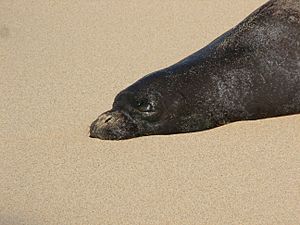
Most Hawaiian monk seals live around the Northwestern Hawaiian Islands. But a small group is growing around the main Hawaiian Islands. These seals spend two-thirds of their time in the ocean. They often look for food in deep waters. They can dive to depths of 300 meters (984 feet) or more.
Hawaiian monk seals have their babies and rest on sand, corals, and volcanic rock. Sandy beaches are often used for giving birth. The Hawaiian Islands are very far from other land. This means the seals' home is limited to these islands.
What Hawaiian Monk Seals Eat
Hawaiian monk seals mostly eat bony fish that live on reefs. They also eat octopus and crabs. Young seals eat more small octopus species and eels. Adult seals prefer larger octopus. Hawaiian monk seals eat many different things. This helps them find food easily. They are good at finding whatever prey is available.
These seals can hold their breath for up to 20 minutes. They can dive more than 549 meters (1800 feet) deep. But they usually dive for about 6 minutes. They go to depths of less than 61 meters (200 feet) to find food on the seafloor.
Who Hunts Hawaiian Monk Seals?
Tiger sharks, great white sharks, and Galapagos sharks are predators of the Hawaiian monk seal.
Hawaiian Monk Seal Life Cycle
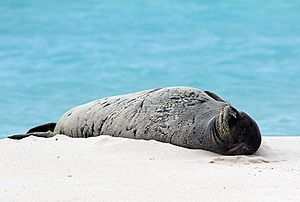
Reproduction
A baby seal grows for nine months inside its mother. Pups are born between March and June. They weigh about 16 kilograms (35 pounds) at birth. They are about 1 meter (3 feet) long. A mother seal usually has one baby pup each year.
Nursing
Pups are born on beaches. Their mothers nurse them for about six weeks. During this time, the mother does not eat or leave her pup. After six weeks, the mother leaves the pup on its own. She then goes back to the sea to find food for herself.
Protecting the Hawaiian Monk Seal
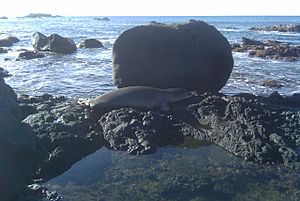
Most Hawaiian monk seals live in the Northwestern Hawaiian Islands.
The Hawaiian monk seal is an endangered animal. Its cousin, the Mediterranean monk seal, is even rarer. The Caribbean monk seal is now extinct. The number of Hawaiian monk seals in the northwest islands is going down. But the smaller group in the main islands is growing. In 2016, there were about 1,400 seals.
The Hawaiian monk seal became an endangered species on November 23, 1976. It is now protected by special laws. These laws make it illegal to harm, catch, or bother a Hawaiian monk seal. Even with these protections, human activities still cause problems for the seals.
Threats to Seals
Many things threaten the Hawaiian monk seal. Some are natural. These include young seals not surviving well. Also, their homes and food sources are shrinking. Male seals can also be aggressive. Other threats come from humans. These include past hunting and getting tangled in ocean trash.
Natural Dangers
Many young seals do not survive. This is often due to starvation or getting tangled in ocean trash. Sharks, like tiger sharks, also hunt young seals. Most adult seals have scars from shark attacks.
Less food can lead to starvation. This happens when their habitat shrinks due to erosion. This makes islands and beaches smaller. Lobsters, a favorite food, have been overfished. Other animals like sharks and barracudas also compete for food. The Papahānaumokuākea Marine National Monument was created to help protect their food supply.
Human Dangers
In the 1800s and 1900s, many seals were killed. People hunted them for their meat, oil, and skin. During World War II, U.S. military forces also hunted them.
Seals can get sick from a disease called toxoplasmosis. This disease comes from cat waste that washes into the ocean. Since 2001, this disease has killed at least eleven seals. Other human-introduced diseases can also infect them.
People bothering seals also causes problems. Seals tend to avoid beaches where they are disturbed. If this happens often, they might leave the beach completely. This reduces the places they can live and have babies. Large crowds and buildings on beaches also limit their habitat.
Fishing can also harm monk seals. Seals can get caught in fishing gear. They can also get tangled in trash like old fishing nets. This is very dangerous because they cannot move or breathe. Hawaiian monk seals get tangled more often than many other seal types.
How We Help
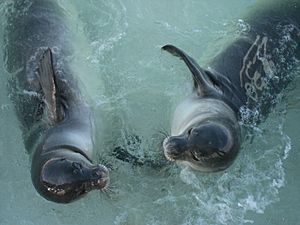
In 1909, President Theodore Roosevelt created the Hawaiian Islands Reservation. This included the Northwest Hawaiian islands. This area later became the Hawaiian Islands National Wildlife Refuge. It is now managed by the U.S. Fish and Wildlife Service.
In the 1980s, the National Marine Fisheries Service said the Northwest Hawaiian Islands were a critical home for the Hawaiian monk seal. This stopped lobster fishing in certain areas. In 2006, a special monument was created. It is called the Papahanaumokuakea Marine National Monument. This monument is one of the largest protected ocean areas in the world. It gives the Hawaiian monk seal even more protection.
Images for kids
-
Hauled-out seal on Laysan Island
See also
 In Spanish: Foca monje de Hawái para niños
In Spanish: Foca monje de Hawái para niños



